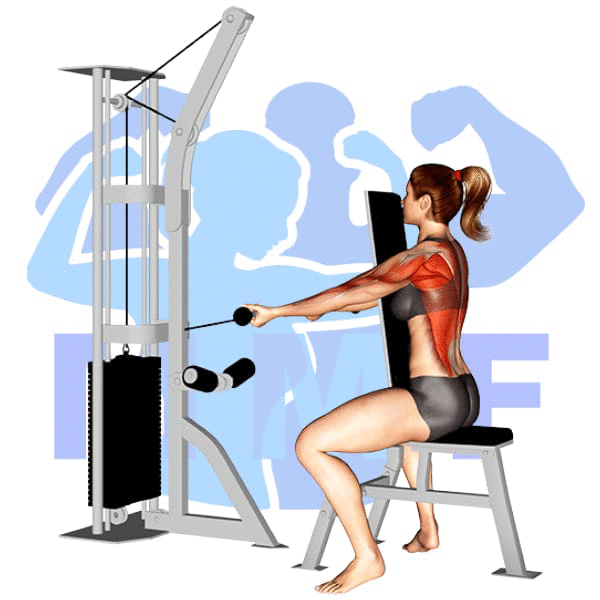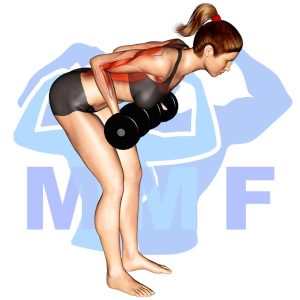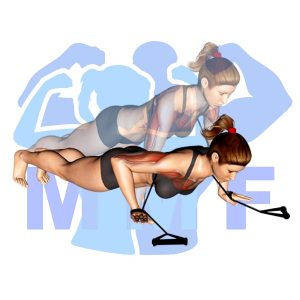As a fitness trainer, I often hear my clients complain about their weak back muscles. With so many exercises to choose from, it can be overwhelming to find one that effectively targets the back. The seated underhand cable row is an ideal exercise for building strength in the upper back and improving posture. Sedentary lifestyles and desk jobs can weaken the back muscles, leading to poor posture. Fortunately, the seated underhand cable row is an effective solution to counteract these effects. In this post, I will guide you through the proper form and technique of the seated underhand cable row so that you can strengthen and tone your upper back muscles and improve your posture.
Seated Underhand Cable Row Summary
- Primary Muscles: Deltoid – Posterior
- Secondary Muscles: Brachialis, Brachioradialis, Pectoralis Major – Sternal
- Equipment: Cable Machine with Straight Bar and Bench
- Mechanics Type: Compound
- Force: Pull
- Utility: Basic or Auxiliary

Seated Underhand Cable Row Instructions
- Start by sitting on the seat or bench to grabbing the cable bar with an underhand grip.
- Place your feet on the foot support if equipped.
- Then, position yourself to pull the bar while maintaining good posture.
- Pull the bar to your abdomen with good posture, pulling with your shoulders and elbows back.
- Finally, resist the cable as it extends your arms, bringing your shoulders forward.
- Repeat these underhand cable rows for 6-12 repetitions.
Video Tutorial
Seated Underhand Cable Row Muscles
Target (Agonist)
- Deltoid – Posterior
- Erector Spinae
- Infraspinatus
- Latissimus Dorsi
- Rhomboids
- Teres Major
- Teres Minor
- Trapezius
Synergists
- Brachialis
- Brachioradialis
- Pectoralis Major – Sternal
Dynamic Stabilizers
- Biceps Brachii
- Triceps – Long Head
Stabilizers
- Adductor Magnus
- Gluteus Maximus
- Hamstrings
Antagonist Stabilizers
- None

Benefits of Seated Underhand Cable Row
The Seated Underhand Cable Row exercise is beneficial for strength training and fitness routines because it can effectively target the posterior deltoid muscles. This exercise requires the user to sit on a bench and grip a cable bar with an underhand grip. When performing this exercise, the user should pull the cable bar towards their chest, squeezing the posterior deltoids in the process. The Seated Underhand Cable Row exercise can be beneficial for increasing strength and size of the posterior deltoids, helping to improve overall shoulder stability and strength.
Tips for Performing Seated Underhand Cable Row
Your at the right place if you’re motivated to enhance your seated underhand cable row execution. These tips can allow you to fully benefit from this first-class exercise and make the best of its results. You will shape your upper back muscles, and even reduce your chances of experiencing an injury. Let’s begin and take a look at how these tips will benefit you.
- Engage your core: Keep your core tight and engaged while conducting the exercise to ensure that your back remains in a neutral position. This will help you maintain proper form and will lead to better results.
- Use Proper Form: Make sure that you keep your elbows close to your body and squeeze your shoulder blades together while pulling the cable back. This will help you target the correct muscles and get the most out of the exercise.
- Take it Slow: Don’t rush through the motion, but instead take your time to ensure that your form is correct and that you are engaging the right muscles. Doing this will ensure that you are getting the most out of the exercise and will help you stay safe from injury.
Benefits and Tips Video
Frequent Mistakes To Avoid
When conducting seated underhand cable row, avoiding common mistakes can be the difference between a productive workout and a debilitating injury. Additionally, getting optimal results from this exercise requires proper technique, and avoiding perform typical errors can allow you to perform the exercise correctly and obtain your desired results. However, take it easy, it’s not as challenging as it might seem. By knowing the mistakes to avoid and taking the right actions, you may complete the exercise safely and effectively. So let’s get started on avoiding those common mistakes and making this exercise a normal part of your fitness training.
- Not using proper form: It is important to maintain a straight back, with shoulders pulled back and down, when performing this exercise in order to maximize its effectiveness and prevent injury.
- Rushing through the movement: Taking the time to perform each rep with control and proper form will help to ensure that you are getting the most out of the exercise and avoiding any strain or injury.
- Not using proper weight: Using too heavy or too light of a weight can make the exercise less effective or even dangerous. It is important to choose a weight that is challenging, but still allows you to maintain proper form and control throughout the movement.
Find More Cable Exercises Here
Variations and Complementary Exercises
If you are looking for additional exercises that can help you build similar muscle groups as the Seated Underhand Cable Row, the following list of variations, complementary, and alternative exercises should help. Each of the exercises will work the same muscles in slightly different ways to build strength and endurance.
Inverted Row

The Inverted Row is an excellent alternative to the Seated Underhand Cable Row. It is a bodyweight exercise that works the same muscles as the seated row, but can be done anywhere with minimal equipment. The inverted row requires you to pull your body up towards a bar, using your arms and back muscles, while maintaining a stable core. This exercise helps strengthen and build the latissimus dorsi, trapezius, and rhomboid muscles, as well as other smaller muscles of the back. It also helps to improve posture and balance. By strengthening these muscles, the inverted row can be used to complement the seated row, or can even be used as an alternative exercise if desired.
Reverse Grip Bent Over Dumbbell Row

Reverse Grip Bent Over Dumbbell Row is an excellent complementary or alternative exercise to Seated Underhand Cable Row. This exercise is great for targeting the back muscles and can be used to increase strength and muscle mass. It is performed by standing with feet hip-width apart, slightly bending the knees and keeping the back straight. The dumbbells are then held with a reverse grip and pulled up towards the chest while squeezing the shoulder blades together. This exercise helps to build strength and size in the lats, rhomboids, traps, and biceps, making it an ideal choice for those looking to complement their Seated Underhand Cable Row workout.
Bent Over Rotating Dumbbell Row

The Bent Over Rotating Dumbbell Row is a great complementary or alternative exercise to the Seated Underhand Cable Row. This exercise works the same muscles as the Seated Underhand Cable Row and helps to build strength in the back, shoulders, and arms. The Bent Over Rotating Dumbbell Row is performed by bending at the waist and using a dumbbell in each hand. As you row the dumbbells up towards your chest, rotate your wrists outwards and then inwards. This helps to engage the muscles in the back and shoulders more than a standard row. This exercise can be done with lighter weights for higher reps or heavier weights for lower reps depending on the individual’s goals.
Check Out These Top Cable Exercises
Bent Over Dumbbell Row

The Bent Over Dumbbell Row is a great complementary or alternative exercise to the Seated Underhand Cable Row. This exercise targets the back muscles, specifically the lats, rhomboids and traps. The exercise is done by bending over at the waist and using a dumbbell in each hand. You then row the dumbbells up towards your chest, keeping your back straight and elbows close to your body. This exercise is a great way to add variety to your workout and strengthen the muscles used in the Seated Underhand Cable Row.
Dumbbell Lateral Raise

The dumbbell lateral raise is a great complementary exercise to the seated underhand cable row. It focuses on the lateral head of the deltoid, while the seated underhand cable row works the medial and posterior deltoids. To perform the dumbbell lateral raise, stand with your feet shoulder-width apart and hold a dumbbell in each hand with a neutral grip. Keep your arms straight and raise the weights up to shoulder height, focusing on contracting your lateral deltoid. Lower the weights back to the starting position and repeat for desired reps. This exercise is an ideal alternative for those looking to add variation to their shoulder routine.
Lat Pulldown

Lat Pulldown is a great complementary exercise to the Seated Underhand Cable Row. Both exercises target the back muscles, but Lat Pulldown places more emphasis on the latissimus dorsi, or lats. By using a wide grip, you can really isolate the lats and get a good pulldown. It’s also a great alternative exercise for those who may have difficulty with the underhand cable row due to shoulder mobility or wrist pain. It’s important to keep proper form in mind when doing Lat Pulldown; use a slow and controlled motion and focus on squeezing your shoulder blades together at the top of the movement. With proper form and regular practice, Lat Pulldown can help strengthen your back and improve your overall fitness.
Find More Back Exercises Here
Opposing Complementary Exercises
To maximize the effects of your seated underhand cable row, pair it with exercises that target opposing muscle groups. This will help to create a balanced workout and ensure that you are developing all the muscles you need to stay strong and healthy. The following exercises are excellent complements to the seated underhand cable row and will help you get the most out of your workout.
Resistance Band Flys

Resistance Band Flys are an excellent complement to the Seated Underhand Cable Row exercise. Resistance Band Flys target the opposing muscle group of the Seated Underhand Cable Row, which is the chest. This exercise helps to create balance between the back and chest muscles. To perform a Resistance Band Fly, you will stand with your feet shoulder-width apart, holding the band in each hand, with your arms slightly bent. You will then raise your arms out to the sides in a wide arc, keeping your arms at shoulder height. This exercise is great for strengthening and toning the chest muscles. By including both Resistance Band Flys and Seated Underhand Cable Rows in your workout routine, you will ensure that your back and chest muscles are both worked equally, resulting in a well-balanced physique.
Resistance Band Chest Press

The Resistance Band Chest Press is a great complementary exercise to the Seated Underhand Cable Row. It works the opposing muscle group of the chest and shoulders while the Seated Underhand Cable Row works the back and biceps. Resistance Band Chest Press helps to balance out the muscles and ensure a complete upper body workout. By using the opposing muscle group, this exercise helps to strengthen both the chest and back muscles and promote overall upper body strength.
Resistance Band Push Ups

Resistance Band Push Ups are a great way to complement the exercise Seated Underhand Cable Row. Resistance Band Push Ups engage the chest and triceps muscles while Seated Underhand Cable Rows activate the back muscles, specifically the lats. By performing both exercises, you can target opposing muscle groups and ensure balanced development of your upper body. This is important for overall strength and stability and to help prevent injury.
Row Your Way to a Stronger Back: Try Seated Underhand Cable Row!
The seated underhand cable row is an excellent exercise to strengthen the muscles in your back, specifically your lats, teres major, biceps, and rhomboids. It is a variation of the traditional row that uses an underhand grip to target different muscles. This exercise is great for those who have trouble with their posture, as it promotes good alignment of the spine. Using the cable machine can also allow for a wide range of motion, making it a versatile exercise to add to your routine.
References: Wikipedia | ExRx.net | PubMed.gov | Comprehensive List of Back Cable Exercises

